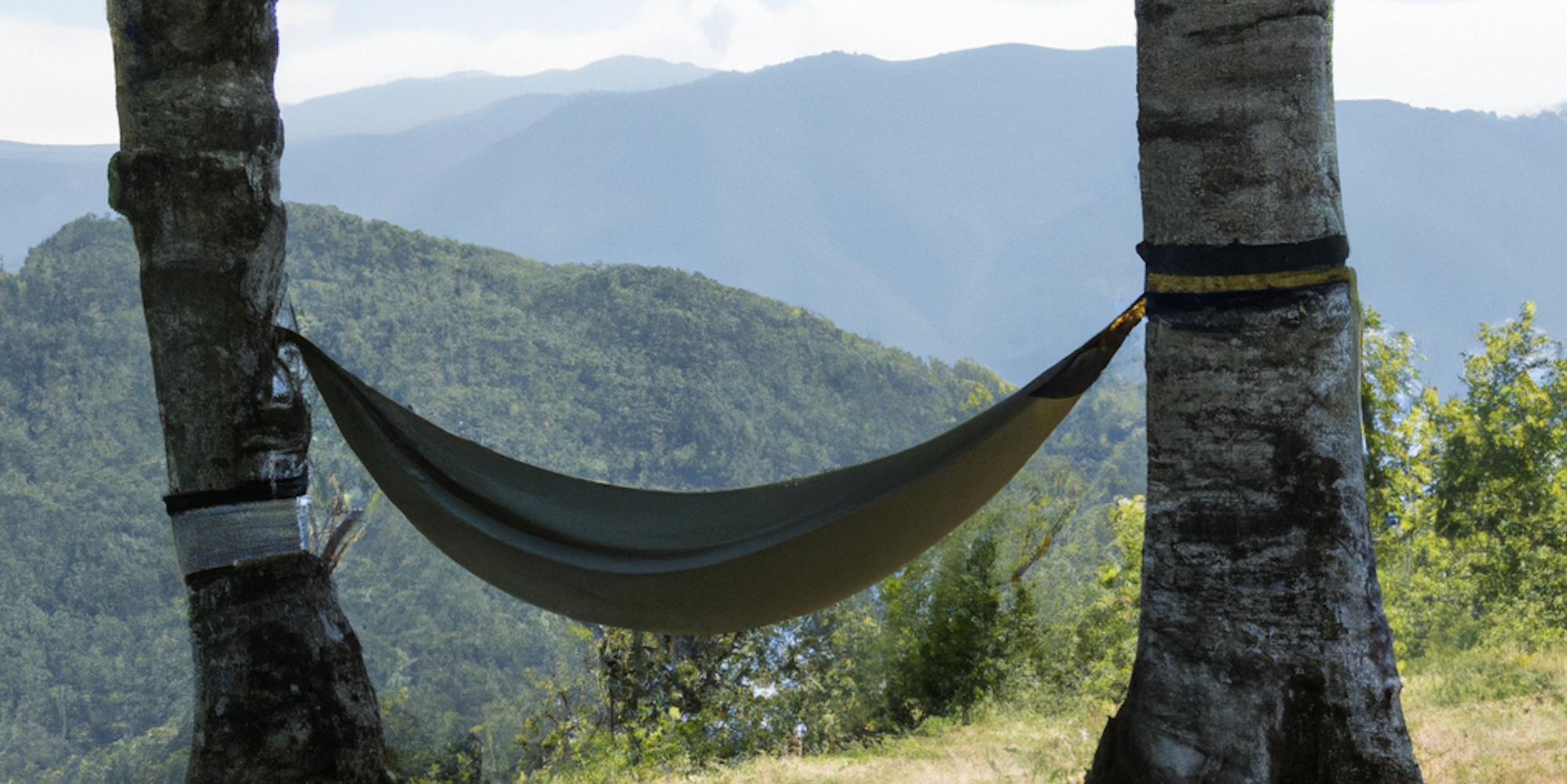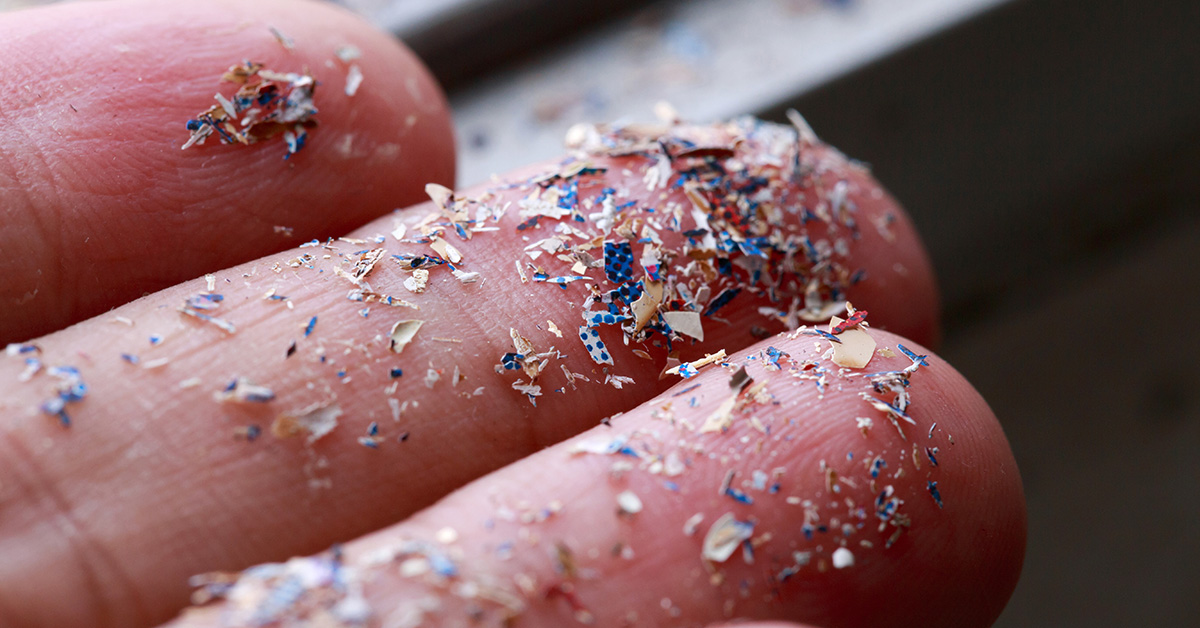Table of Contents
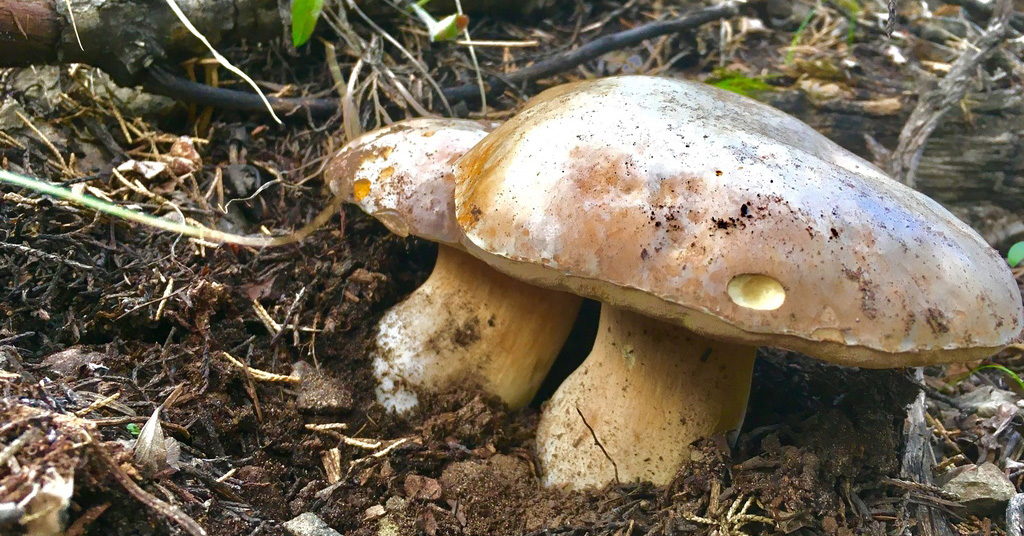
The Ultimate Guide to Foraging Boletes
Every experienced mushroom hunter has a good bolete story. After all they’re a big part of mushroom culture. Bolete season, which is often only a small part of mushroom season, is the favorite time of year for many foragers. They can be one of the most abundant mushrooms when the season is right (more than you want to carry home type of abundance) and they’re absolutely delicious.
For new foragers Boletes are also an easy and safe start into the world of mushrooms. They are easy to distinguish, have no fatal-lookalikes, and are a generally safe group compared to gilled mushrooms.
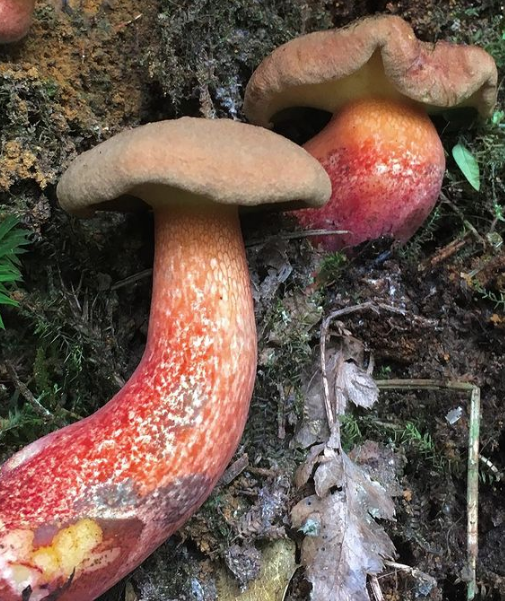 Some boletes have exotic coloring and textures. This species I found in the cloud forests of Veracruz is particularly curious!
Some boletes have exotic coloring and textures. This species I found in the cloud forests of Veracruz is particularly curious!
What is a Bolete Mushroom?
The answer to this question really depends on who you ask. In general, the term Bolete is used to refer to a wide range of fleshy mushrooms that are characterized by the spongy tissue found on the underside of the cap. This spongy tissue is made up of small tubes that give the appearance of “pores” on their exposed side. When most mushroom hunters talk about “Boletes” they’re talking about the choice edible Boletus edulis and close relatives. These also go by the names of King Boletes and Porcini.
Boletiod Unraveled
Boletiod is a term used to refer to all “bolete-like” mushrooms. These include hundreds of species with a stem, cap, and the notorious spongy bottom. Some boletoid mushrooms are considered delicious edibles while others are not. Boletiods come in all shapes and forms, sometimes with astounding colors and ornamentation.
“King Boletes” or “Porcini” is a group of similar looking and closely related boletes that are highly regarded for their edibility. Believe it or not, these choice boletes occur in every continent other than Antarctica! While these mushrooms are valued across the world and were historically viewed as few species, it turns out there may be more than 50 different types of “Porcini” style mushrooms. These are boletes in the classification Boletus section boletus, with the most notable species being Boletus edulis. These are the mushrooms most people are talking about when they say they’re going looking for boletes!
5 Tips For Finding Boletes
If you are foraging for bolete mushrooms, then these 5 tips will guide you to what environment boletes like!
1. Find Your Host Trees
Boletes are mycorrhizal mushrooms. This means they associate with host trees that provide them with energy rich sugars in exchange for minerals, water, and other services. This is why boletes only grow in forests or woodlands!
The most common hosts for King Boletes are pines or other coniferous trees. In fact, research on this subject has suggested that in North America all the hosts of King Boletes and the related species are coniferous trees. While many mushroom hunters have claimed finding them under Oak, this is highly debated by some lead researchers on this subject. Other coniferous hosts include Fir (Abies), Douglas Fir (Psuedotsuga), and Spruce (Picea).
While it’s debated whether “Kings” really associate with Oak, many other types of boletes do associate with Oak. This includes many of the most exotic and unique boletes! A group of edile boletoid mushrooms in the genus Leccinum also associate with unique hosts. These include trees like Birch, Aspen, Manzanitas, and Madrones. These unique and specialized relationships are what give merit to the common names of “Birch Bolete” “Aspen Bolete” and “Manzanita Bolete” for said species.
2. Kings Love Edges
For this reason, they are jokingly called Boletus “edgeulis” . Walking along forest roads or the edge of a meadow can bring promising results.
3. Hit The Season
When Boletes are out, they’re out. If you know your friends are finding them, or the local Facebook Mushroom Group shows folks are finding them, go to your woods. Sometimes Boletes are only out for 2-4 weeks so don’t miss your chance!
4. Find The Elevation
This is true for “Spring Kings” and many spring mushrooms in mountainous regions. Since these often appear after snowmelt, the season progresses later as you go up the mountain.
5. Bump The Shrumps
Shrumps are the combination of two words. Shroom and Bump. This term is used to refer to small “Bumps” that form from the dirt and leaf litter lifted by the fruiting mushrooms. This is common with Boletes in mountainous regions or in places with heavy leaf litter. It’s great to check any suspicious “bumps” by poking them or gently removed any debris. You never know what you may find!
Bolete Identification and Types
If your just starting with mushroom hunting, boletes can be an easy start on your search for edible mushrooms. In particular learning how to identify the “King Bolete” or “Porcini” mushrooms is simple and no-brainer once you get around to learning their features. Once you learn these you can move on to learn other more exotic edible boletes!
Identification Features of “King Boletes” (Boletus section boletus)
- Slight reticulation along the stem, particularly near the cap.
- Pores are white when young and slowly begin turning yellow with age.
- They do not stain blue, red, or any other color when damaged.
- The base of stems is often wider than the top.
- Stems are light-colored
- Caps are smooth with a color ranging from tan to red. In some cases caps can be completely white.
- King Boletes can be BIG. Their size at maturity ranges from the size of your hand up to 1/2 meter large!
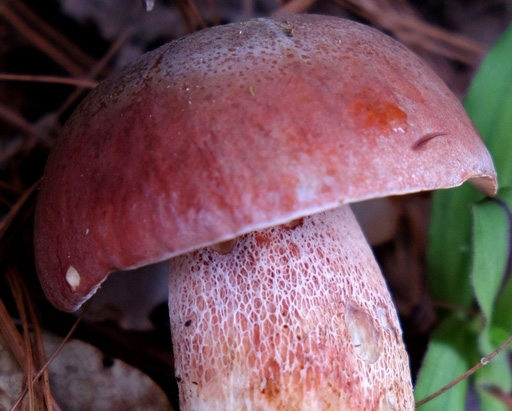 This is the typical reticulation common on Boletus species. This species, Boletus pinophilus, has a particularly red tint.
This is the typical reticulation common on Boletus species. This species, Boletus pinophilus, has a particularly red tint.
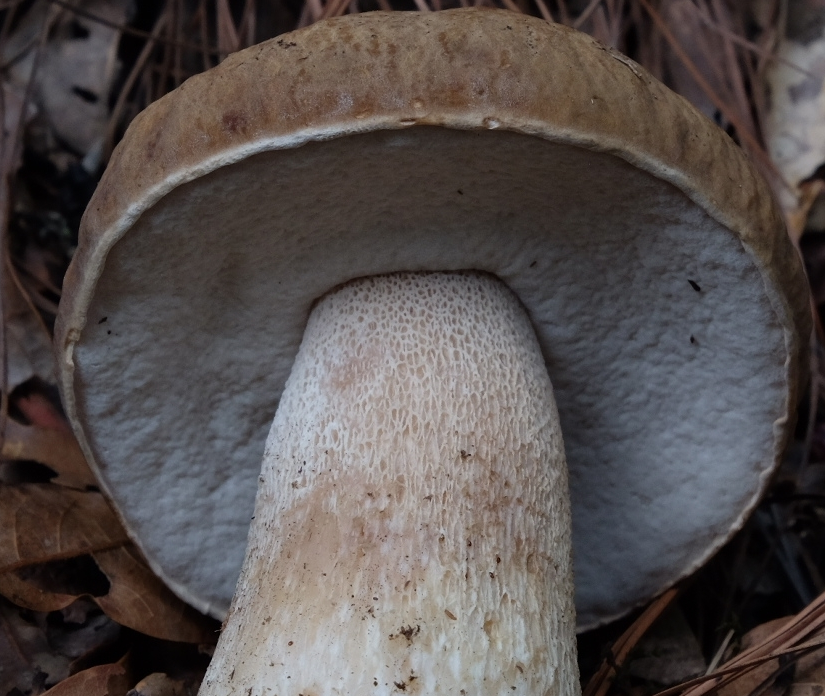 This is the more generic appearence of the Boletus edulis types species. As this specimen ages the cap flattens out while the pores become exposed and darken to yellow.
This is the more generic appearence of the Boletus edulis types species. As this specimen ages the cap flattens out while the pores become exposed and darken to yellow.
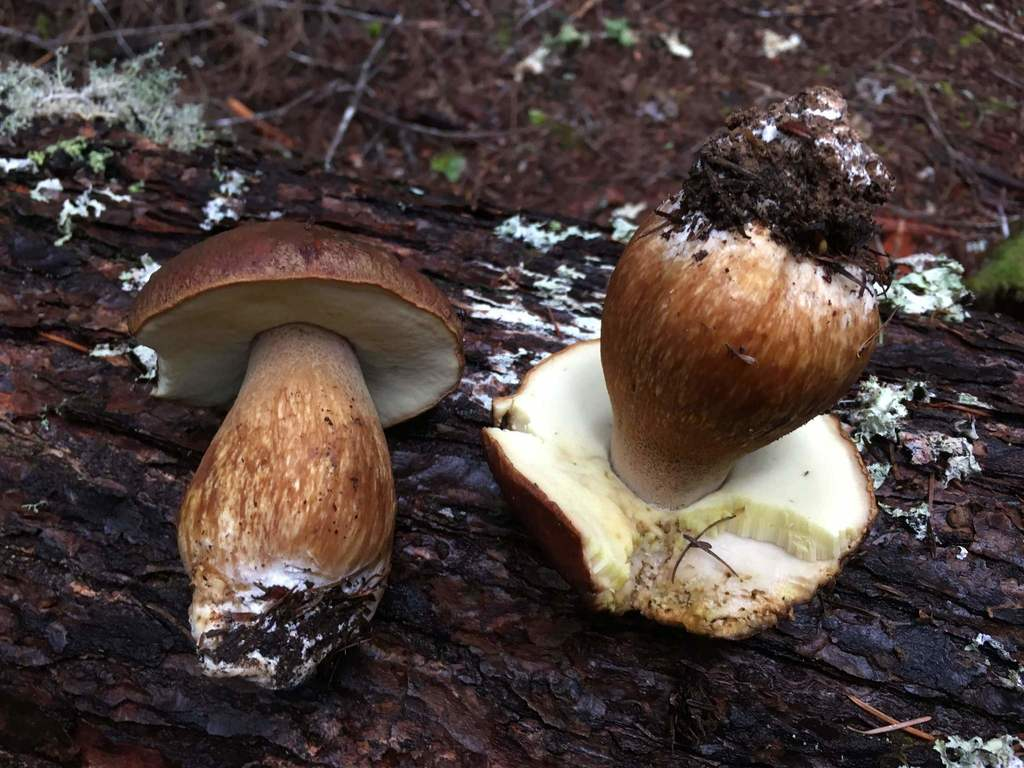 This is what a prime “Porcini” look like. At this age they’re firm, free of bugs, and the most delicious!
This is what a prime “Porcini” look like. At this age they’re firm, free of bugs, and the most delicious!
Other Edible Boletes
While King Boletes are the most prized of the bunch, there are many other delicious and edible boletes. Boletes of all shapes and colors with unique textures and flavors to experience. For example, the Red-capped Scaber Stalk pictured below has a tough chewy stem that provides an outstanding texture. Strobilomyces has strong umami-like flavor that can be overpowering for some.
The Scaber Stalks - “Leccinum”
There are many different Leccinum species, lots of which are considered choice edibles. It must be said that there have been many reports of orange capped Leccinums causing gastrointestinal distress in some folks. So becareful if you’ve got a sensitive stomach!
Like previously mentioned, Leccinum species tend to form specialized relationships with certain tree species such as Birch, Aspen, and Manzanitas. Identifying a Leccinum to genus can be simple by the carachteristic scales called “scabers” that form on their stem. This is in contrast to the reticulated texture that forms on Boletus. Identifying Leccinum to species can be a bit more difficult in some cases.
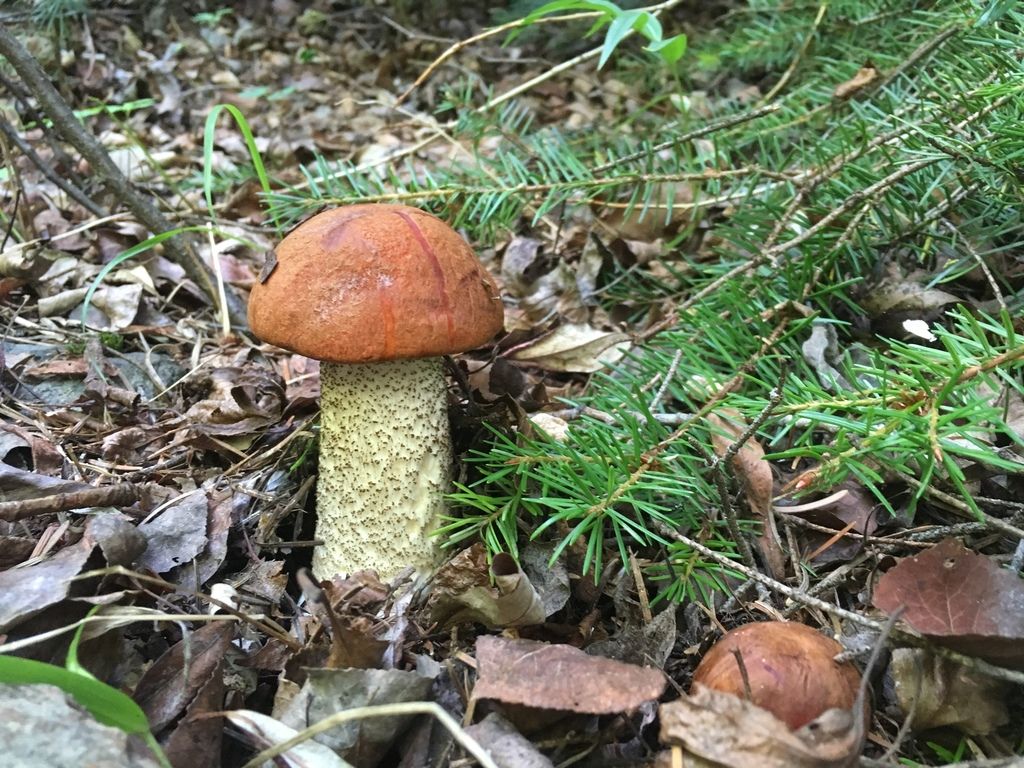 Red-capped Scaber Stalk or Leccinum aurantiacum growing with Aspen in the mountains of Colorado. While this is considered a choice edible, some have reported digestive issues following it’s consumption.
Red-capped Scaber Stalk or Leccinum aurantiacum growing with Aspen in the mountains of Colorado. While this is considered a choice edible, some have reported digestive issues following it’s consumption.
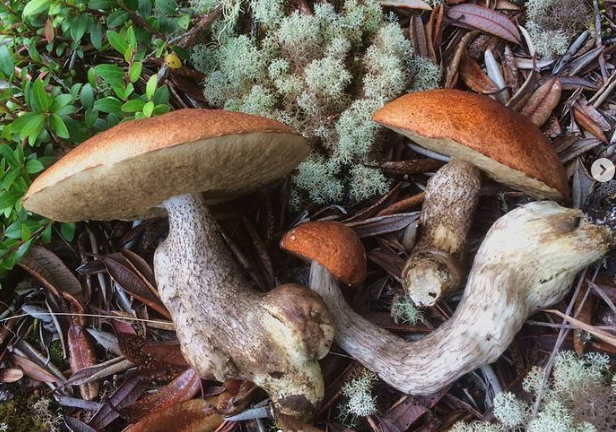 Leccinum monticola is a rare boletoid from some of the highest altitude forests in Central America. While I hadn’t found many reports of it’s ebility, I gave it a try. It was delicious!
Leccinum monticola is a rare boletoid from some of the highest altitude forests in Central America. While I hadn’t found many reports of it’s ebility, I gave it a try. It was delicious!
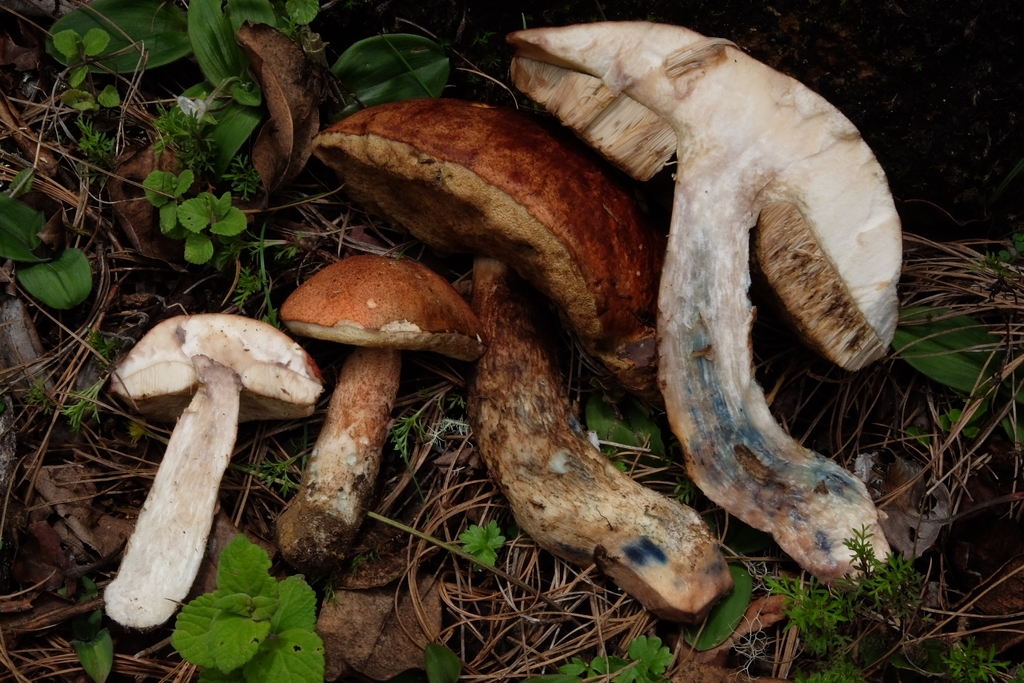 Many Leccinums bruise blue when damaged. You should be careful with blue staining boletes beacuse some are delicious edibles and others are toxic.
Many Leccinums bruise blue when damaged. You should be careful with blue staining boletes beacuse some are delicious edibles and others are toxic.
Aureoboletus projectellus
This is another really cool bolete that shares some traits with Russel’s bolete (Boletellus russellii). In particular it has the raised reticulation on the stem. It’s not very common but it is delicious!
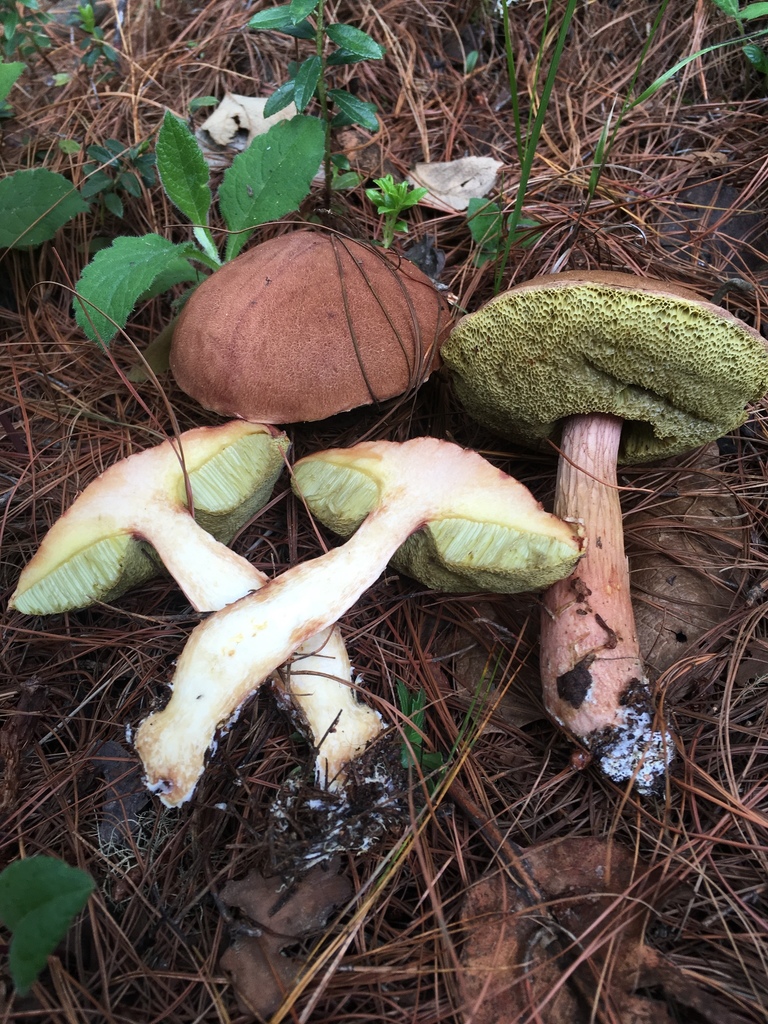 Aureoboletus sp. growing with pine.
Aureoboletus sp. growing with pine.
Old Man Of The Woods - Strobilomyces
This is a surprising bolete, unique for its grey/black coloring. There are several species in the genus the most notable being Strobilomyces strobilaceus. These grow strictly in and east of the rockies in US and Canada down into Mexico. Grows with oaks. It is edible but it’s flavor can be a bit strong. I’m still experimenting with good recipies for this one!
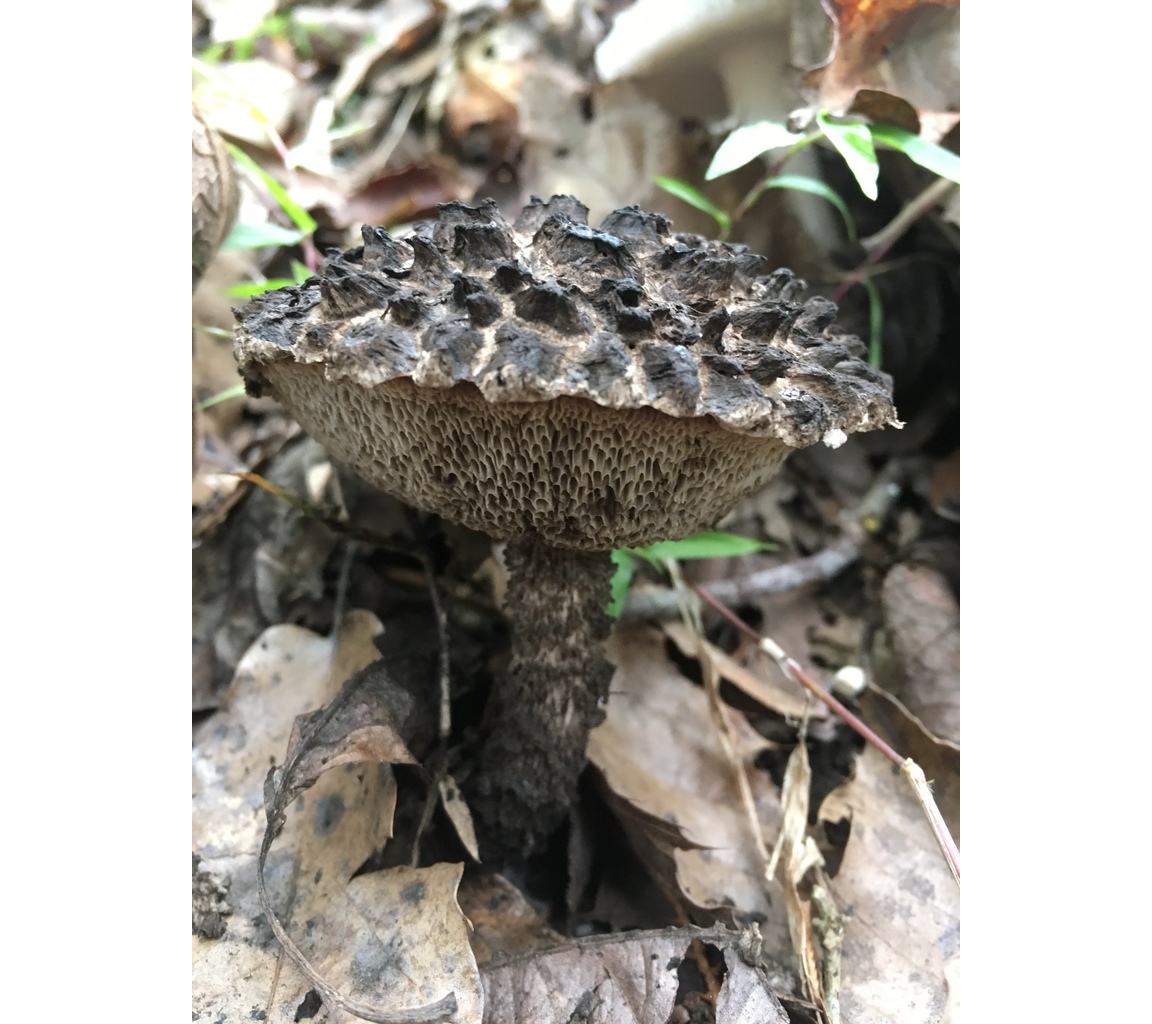 Strobilomyces or “Old Man Of The Woods”
Strobilomyces or “Old Man Of The Woods”
Russels Bolete - Boletellus russelli
This bolete has a shaggy reticulated stipe. It is delicious for eating because the texture is a bit crunchy, making it unique. This grows with oaks in eastern US, Canada, and Mexico.
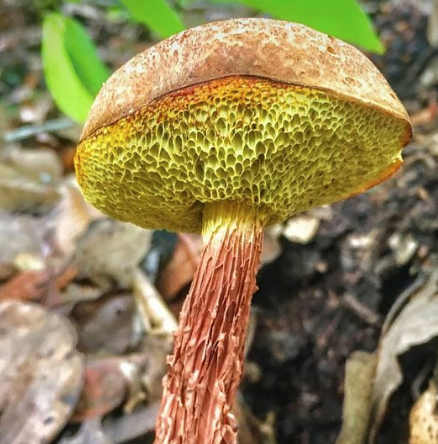 This is a form of Boletellus russellii found in the cloud forests of Veracruz, Mexico. Notice the raised edges on the reticulation in the stem. This species is edible and delicious.
This is a form of Boletellus russellii found in the cloud forests of Veracruz, Mexico. Notice the raised edges on the reticulation in the stem. This species is edible and delicious.
Pineapple Bolete - Boletellus ananas
This is another Oak loving and eastern Bolete. It’s distinguished by the shaggy scales on the cap. These are distinguished from other boletes by the presence of a “partial vei”l. This is a thin ring-like tissue that covers the pores when the mushroom is young.
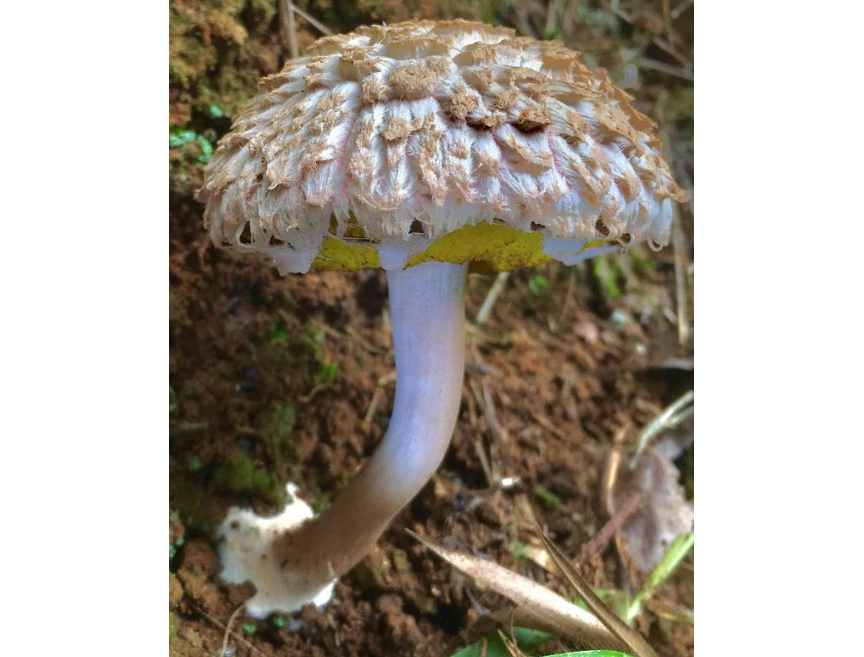
Rules Of Thumb For “Edible Boletes”
While there are too many edible boletiods to mention in this guide, mushroom enthusiasts and experts have devised some rules of thumb when it comes to edible boletes. Many experts claim that if your boletes meets the all the following criteria than it should be good eating.
Doesn’t Have Bitter Tastes You can take a small bite of the bolete and see if it’s bitter. Edible boletes have mild flavors that may be described as slightly nutty. “Bitter Boletes” will have a mild to intense bitterness after 10-15 seconds on the tongue.
Doesn’t Stain Blue While there are some delicious edibles that stain blue, there are many others that are poisonous.
Doesn’t Have Red/Orange Pores The most toxic of all edible boletes have red to orange pore surfaces. This is the case for “Satans Bolete” aka Boletus satanas.
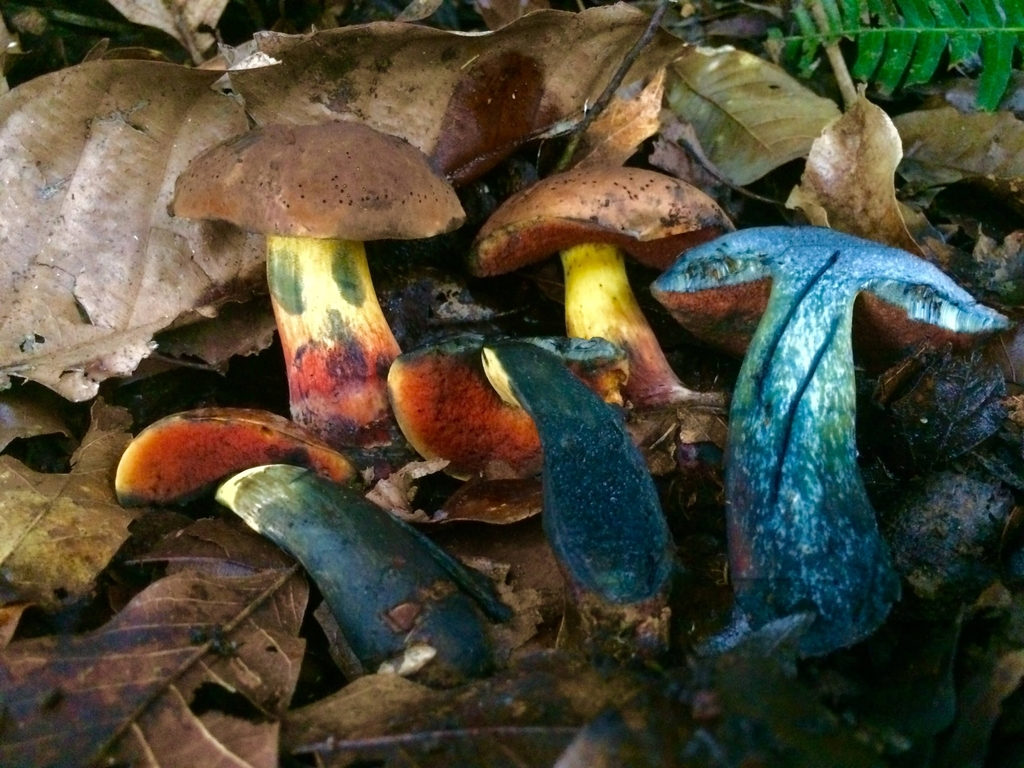 A potentially toxic, red pored and blue staining bolete possibly in the genus Neoboletus. Identifying obscure boletes like this one can be difficult if you’re only using macromorphological features.
A potentially toxic, red pored and blue staining bolete possibly in the genus Neoboletus. Identifying obscure boletes like this one can be difficult if you’re only using macromorphological features.
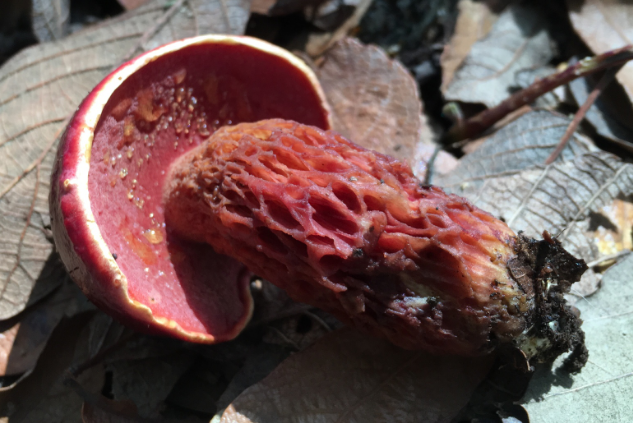 “Frosts Bolete” or Exudoporus frostii is a red pores bolete that often displays the liquid exudates on its cap. While this is edible, it is not reccomended for beginers due to it’s simmiliarities with toxic species!
“Frosts Bolete” or Exudoporus frostii is a red pores bolete that often displays the liquid exudates on its cap. While this is edible, it is not reccomended for beginers due to it’s simmiliarities with toxic species!
I would still use caution using this rule, especially outside of North America, but thankfully there isn’t deadly Boletes. There are some that can cause some serious stomach issues, but those are usually less common and with exotic appearances.
Gilled Boletes, Gastroboletes, and Other Oddities
Boletes are not just a morphological group of mushrooms but are grouped together via genetic analysis. While the taxonomy associated with the Bolete family is tricky, it is known there are some oddities in the lineage.
This includes gilled boletes like phylloporus sp. which from afar often resemble boletes. Once observe from closer up you see they have bright yellow gills! Another strange relative is the Gastroboletes which have evolved a morphology resembling a puff ball!
Another interesting, and edible, bolete is xx which exhibits saprotrophic behavior. This means unlike other boletes this species does not form mycorrhizal relationships with host trees. Instead it is found on the decomposing trunks of pinus radiata in California.
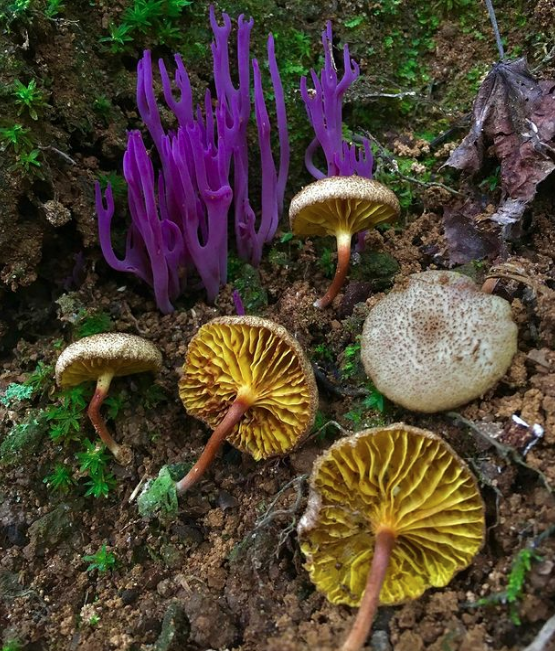 Why am I showing you a picture of these gilled mushrooms? This is Phylloporus, a gilled member of the Bolete family. While not really considered a choice edible, it is an extremely curious group of species!
Why am I showing you a picture of these gilled mushrooms? This is Phylloporus, a gilled member of the Bolete family. While not really considered a choice edible, it is an extremely curious group of species!
Other Considerations
Cleaning King Boletes
Boletes are usually pretty clean mushrooms, other than the stem butt that is often crusted with dirt. I recommend just cutting this piece off, ideally in the field when harvesting. Other than that you can use your knife or a brush to remove any dirt. Becareful when packing it into your basket or bag as to not get it dirty from other mushrooms.
Rotten or Not?
If you start finding King Boletes, you’ll notice some are in better condition than others. Some may seem good from the outside, but within they are crawling with small larvae. You can easily test this by gently squeezing the stem. It should be firm. If its soft or brittle then you’ve been beat by the bugs!
A Word On The Pores
If you are not into slimy textures it is often recommended to remove the pores before cooking. This is especially true in older specimens. You can dehydrate and powder the pores or use them in sauces or soups.
Dehydrating Boletes
If you have a dehydrator, or adequate weather, than dehydrating boletes is an excellent option. Many people do this specifically with older or larvae infested specimens. They can be preserved like this for years and their flavour is great. Curing your dried Boletes in a jar can actually improve the flavor!
